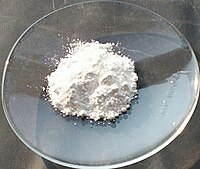
Photo from wikipedia
The power generated by flexible wearable devices (FWDs) is normally insufficient to eradicate bacteria, and many conventional antibacterial strategies are also not suitable for flexible and wearable applications because of… Click to show full abstract
The power generated by flexible wearable devices (FWDs) is normally insufficient to eradicate bacteria, and many conventional antibacterial strategies are also not suitable for flexible and wearable applications because of the strict mechanical and electrical requirements. Here, polypyrrole (PPy), a conductive polymer with a high mass density, is used to form a nanostructured surface on FWDs for antibacterial purposes. The conductive films with PPy nanorods (PNRs) are found to sterilize 98.2 ± 1.6% of Staphylococcus aureus and 99.6 ± 0.2% of Escherichia coli upon mild electrification (1 V). Bacteria killing stems from membrane stress produced by the PNRs and membrane depolarization caused by electrical neutralization. Additionally, the PNR films exhibit excellent biosafety and electrical stability. The results represent pioneering work in fabricating antibacterial components for FWDs by comprehensively taking into consideration the required conductivity, mechanical properties, and biosafety.
Journal Title: Research
Year Published: 2023
Link to full text (if available)
Share on Social Media: Sign Up to like & get
recommendations!